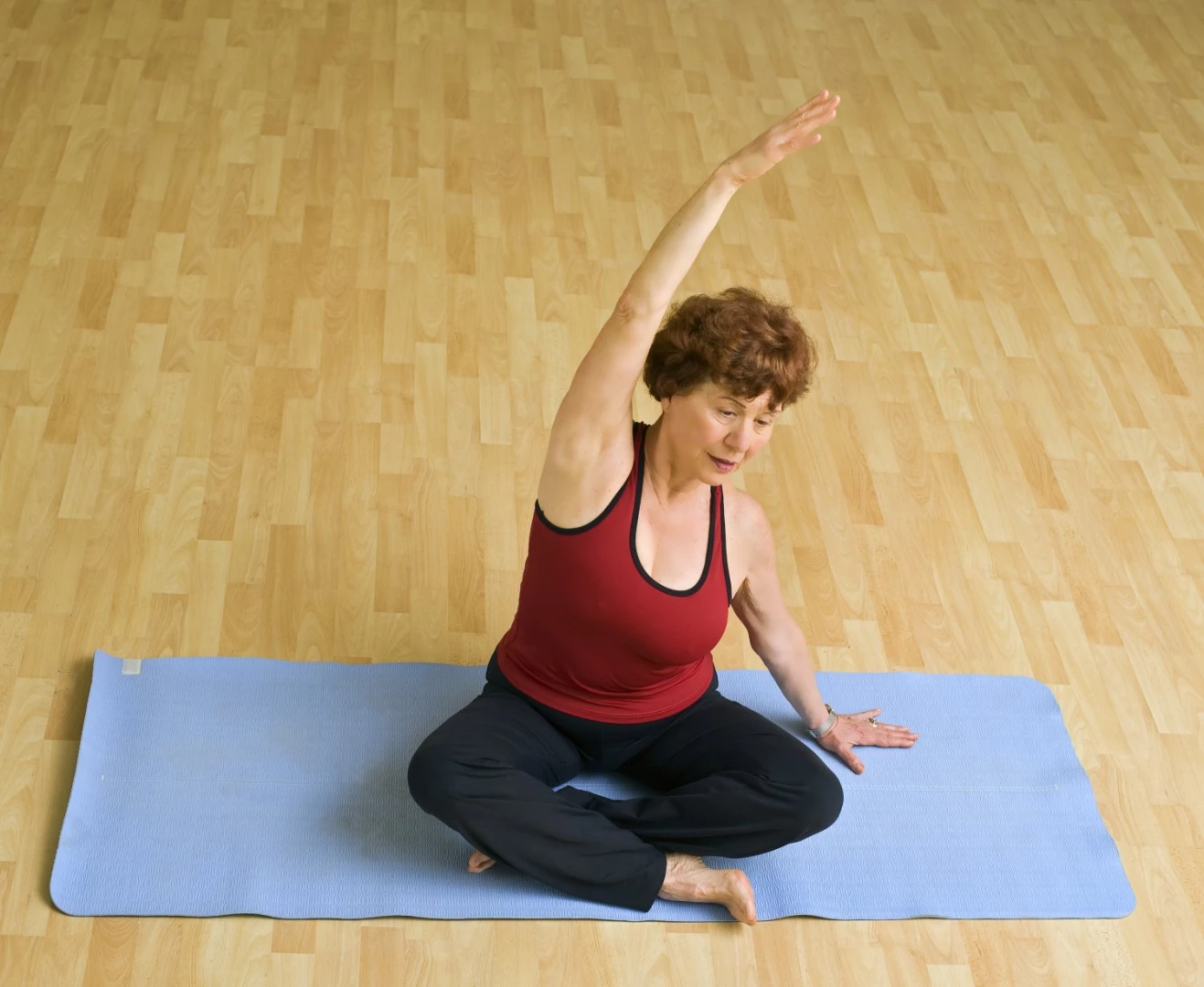Can Yoga Reduce the Pain of Arthritis? Reviews of the Research are Promising

More than 46 million adults in the United States suffer from the stiff, inflamed joints, decreased joint function, and chronic pain of arthritis. Two new reviews of the research suggest that yoga may help to relieve some of the symptoms of this common, chronic and often debilitating disease.
The American College of Rheumatology (ACR) and Osteoarthritis Research Society International (OARSI) recommend stretching and strengthening exercises for individuals with arthritis. But reduced joint mobility, stiffness, and chronic pain can make exercise very difficult for those with arthritis symptoms.
Yoga has been shown to benefit both the mind and body, providing not only physical improvements such as increased flexibility, range of motion and strength, but also enhancing coping mechanisms to deal with pain. Now two recent systematic reviews of the research suggest that gentle yoga may also help to reduce pain, stiffness and tenderness, and promote an overall increase in function in those suffering from arthritis.
Yoga May Reduce Joint Swelling in People with RA
Systematic reviews evaluate the existing research and draw conclusions based on the scientific evidence. The first review examined all studies conducted between 1980 and 2010 in which yoga was used as therapy for either rheumatoid arthritis (RA) osteoarthritis (OA), or “arthritis in general” in which quantitative data were reported.
A total of 10 articles met final criteria for inclusion. Of these articles, only 6 were published as journal articles, 3 were presented as abstracts at research meetings, and one was a letter to the editor. Typically only peer reviewed journal articles are considered in systematic reviews, so these findings need to be interpreted with caution.
Two studies included RA and OA as well as “arthritis in general”, 6 included only RA, and two included OA only. Of the 10 studies, 4 were randomized controlled trials (RCTs), 2 used a non-randomized control group, 2 a control group matched on age and sex, and 2 used cohort samples. None of the control groups were active. A control group is considered active when one form of therapy (e.g. yoga) is compared to another active treatment (e.g. exercise).
The sample sizes were generally small, and drop out rates ranged from 0-37%. As is often the case in reviews of yoga studies, there was considerable variation in the nature and duration of yoga practice. Practices ranged from 120 minutes, 5 times per week, to 60 minutes, once per week for 8 weeks. Some, but not all yoga interventions included a home practice component. There was also a great deal of variability in the type of yoga practiced, and the nature of instruction.
The findings from these studies varied from some improvement to no change for those receiving the yoga intervention. Authors of the review noted that, “the most consistent findings were for tender or swollen joints in persons with RA, which improved for all 3 studies that used that outcome.” Six of 8 studies that measured pain reported reductions, and 3 of 4 studies that measured disability noted improvements.
The authors were cautious in their interpretation of their findings noting that it is essential that researchers describe the yoga practices in their studies in great detail including specifying the lineage and explicitly noting what was done. They also note that those in the yoga community interested in conducting research in this area should partner with rheumatologists and clinical researchers in order to develop yoga interventions with the greatest benefit.
The second review examined the yoga literature for arthritis published in English between January 2010 and June 2013. Nine articles were identified that met criteria for inclusion (e.g. published in a peer reviewed journal in an indexed database, included yoga as the primary intervention, used quantitative data analyses, measured one of a number of key outcomes).
Of these articles, 5 yoga interventions were conducted in the United States and 4 in India. Two studies used a randomized controlled design (RCT), 1 used a quasi-experimental design, and 5 compared pre- to post-test data. The yoga approaches used included chair yoga (2), “integrated yoga” (2), and Iyengar (1), Hatha (1), and Viniyoga (1). Two of the 9 studies did not report the type of yoga used.
Similar to the previous review, there were considerable differences in the dosage, or amount of yoga instruction received and practiced. The duration of yoga interventions ranged from 6-46 hours, with an average of approximately 18 hours.
Six of 9 studies reported some improvements in one or more physiological or psychological outcome related to arthritis. The other 3 had mixed findings. Consistent with the previous review, improvements were most consistently noted for symptoms including pain, tenderness, and stiffness, as well as disability.
Benefits of Yoga for Arthritis
Authors of both reviews provided cautionary notes when interpreting their reviews. In general, the research regarding the use of yoga for arthritis thus far has been hampered by the same factors that often characterize other research on yoga, including:
-
a lack of specification of the type of yoga practices used,
-
a high degree of variability in the amount of yoga instruction and practice received,
-
a lack of uniformity or standardization of outcome measurement, and
-
the use of small samples and weak research designs.
Bearing these issues in mind, there are some consistencies in these reviews that might allow yoga teachers to be cautiously optimistic about the use of yoga for clients and students with arthritis. Studies consistently show some benefits including reductions in pain, stiffness and tenderness, and overall increases in function.
If you’re one of the millions of people world-wide suffering from arthritis or arthritis-related symptoms, this comes as good news. Yoga may be one approach to improving your quality of life, and reducing pain and physical restriction. As always, it is important to consult your physician or rheumatologist to see what type of program is best for you.
 B Grace Bullock, PhD, E-RYT 500 is a psychologist, research scientist, educator, author, yoga and mindfulness expert and creator of BREATHE: 7 Skills for Mindful Relationships. Her mission is to reduce stress, increase health and wellbeing and improve the quality of relationships. She offers classes, workshops, writing and research that combine the wisdom of applied neuroscience, psychophysiology, psychology and contemplative science and practice. Her goal is to empower individuals, groups, leaders and organizations to reduce chronic stress and increase awareness, attention, compassion, mindfulness and effective communication to strengthen relationships, release dysfunctional patterns and unlock new and healthy ways of being. Dr. Bullock is a Certified Viniyoga Therapist and Faculty at the Integrated Health Yoga Therapy (IHYT) Training program. She is the former Senior Research Scientist at the Mind & Life Institute and former Editor-in-Chief of the International Journal of Yoga Therapy. For more information see www.bgracebullock.com
B Grace Bullock, PhD, E-RYT 500 is a psychologist, research scientist, educator, author, yoga and mindfulness expert and creator of BREATHE: 7 Skills for Mindful Relationships. Her mission is to reduce stress, increase health and wellbeing and improve the quality of relationships. She offers classes, workshops, writing and research that combine the wisdom of applied neuroscience, psychophysiology, psychology and contemplative science and practice. Her goal is to empower individuals, groups, leaders and organizations to reduce chronic stress and increase awareness, attention, compassion, mindfulness and effective communication to strengthen relationships, release dysfunctional patterns and unlock new and healthy ways of being. Dr. Bullock is a Certified Viniyoga Therapist and Faculty at the Integrated Health Yoga Therapy (IHYT) Training program. She is the former Senior Research Scientist at the Mind & Life Institute and former Editor-in-Chief of the International Journal of Yoga Therapy. For more information see www.bgracebullock.com



